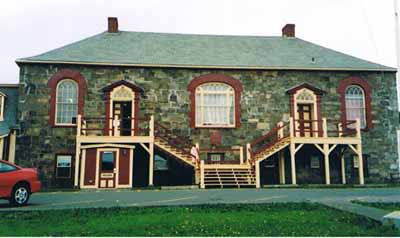Harbour Grace Court House National Historic Site of Canada
Harbour Grace, Newfoundland and Labrador

General view
(© Parks Canada Agency/ Agence Parcs Canada, Bryan Horton, 2005.)
Address :
2 Harvey Street, Harbour Grace, Newfoundland and Labrador
Recognition Statute:
Historic Sites and Monuments Act (R.S.C., 1985, c. H-4)
Designation Date:
1966-05-25
Dates:
-
1830 to 1830
(Construction)
Event, Person, Organization:
-
Patrick Keough [Kough]
(Architect)
-
Patrick Keough [Kough]
(Builder)
Other Name(s):
-
Harbour Grace Court House
(Designation Name)
Plaque(s)
Existing plaque: On building wall above main stairs 2 Harvey Street, Harbour Grace, Newfoundland and Labrador
During the 19th century Harbour Grace was an important centre in Newfoundland and for much of this period it boasted, along with St. John's, one of two court houses in the colony. The present building, constructed in 1830, survives as the oldest public building in the province. It is distinguished as a public building by the large central window and its solid masonry construction. These features make it typical of other Canadian court houses of this period but the inclusion of a residence became characteristic practice in Newfoundland.
Description of Historic Place
Harbour Grace Court House is a two-storey stone institutional building that stands at 2 Harvey St. in Harbour Grace, Newfoundland. Distinguished by a large central window flanked by two entry doors accessed by a split staircase, its design reflects the form and classically inspired aesthetic, typical of many British colonial courthouses. The building included a jail and the jailer’s modest residence is still attached to one end of the courthouse. The official recognition refers to the building on its property.
Heritage Value
Harbour Grace Court House was designated a national historic site in 1966 because: constructed in 1830, it survives as the oldest public building in the province, it is distinguished as a public building by the large central window and its solid masonry construction.
Harbour Grace Court House was built in 1830 in one of Newfoundland’s earliest and most prosperous settlements. It replaced an earlier courthouse with one of more substantial construction containing facilities for a court, a jail and jailer’s residence. It was originally designed and built by Patrick Kough [also known as Keough], a Newfoundland resident, and has been restored since 1980.
The heritage value of Harbour Grace Court House National Historic Site resides in its age and longterm status as a public building as well as in the substantial, distinguished nature of its construction and architectural form.
Source: Historic Sites and Monuments Board of Canada, Minutes, June 1966, May 1974, May 1979, June 1980, December 2004.
Character-Defining Elements
Key features contributing to the heritage value of this site include: the rectangular footprint of the main court house building, with the smaller rectangular footprint of the attached residence; the two-storey cubic massing of the main court building under a hipped roof with end chimneys; the 1 ½ storey rectangular massing of the residence under a mansard roof with dormers;
the court house and gaol; the symmetrical organization of the main facade centred on a large segmentally arched widow with split staircase leading up to two entry doors flanked by smaller segmentally arched windows; the rear facade with its matching large central window flanked by smaller paired windows; its classically inspired details including the split staircase leading to panelled entry doors flanked by pilasters beneath a pediment, the multi-pane sash windows with toplights; its cut stone construction materials with decorative brick window surrounds and wood detailing; its solid-wall masonry construction; surviving evidence of its original interior layout, spatial volumes, detailing and finishes; continuity of its patterns of access and circulation; the high walled jail yard to the rear;
the gaoler’s house; its recessed to one side of the court house; its relatively small scale; its modest, domestic form; its wood construction detailing; surviving evidence of original finishes and domestic layout.